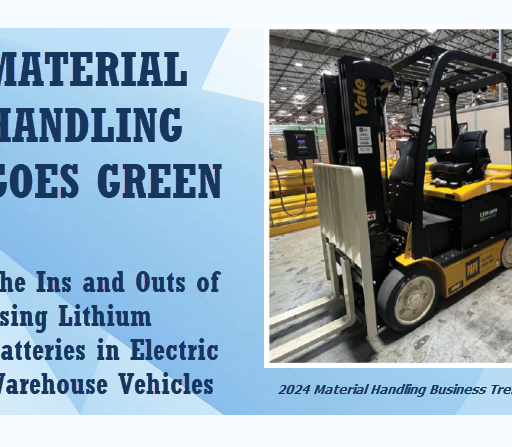2024 Material Handling Business Trend: Members need to be cognizant of environmental, social and corporate governance (ESG) and potential customer and supplier demands for ESG compliance.
View all 2024 Trends at www.mheda.org/trends.
By Elsbeth Russell
 In recent years, the push for sustainable solutions in material handling and logistics has led to the rise of electric forklifts and other warehouse vehicles.
In recent years, the push for sustainable solutions in material handling and logistics has led to the rise of electric forklifts and other warehouse vehicles.
These eco-friendly alternatives to traditional internal combustion engines have proven cost-effective, efficient and environmentally responsible. Central to the success of electric warehouse vehicles are their lithium batteries, which have revolutionized the way these machines operate.
Historically, the batteries most commonly found in warehouse vehicles were lead acid. These batteries have been in use for 150 years. Conversely, the lithium-ion battery was invented in the early 1980s and commercialized in the 1990s.
Since then, though, the technology has quickly advanced and improved, with many different sub-chemistries, shapes and sizes following suit.
Those who have made the switch from lead-acid to lithium-ion batteries say the benefits are there for those approaching the use of this new technology with an open mind and a plan to succeed.
Making the Transition to an Electric Fleet
When fleet managers decide to integrate lithium batteries into their fleets, Eric Sledge, the lithium product manager at Stryten Energy says there are many benefits to be recognized.
“It’s got greater energy density, which means it’ll run longer, and has a greater cycle life and calendar life,” he explained. Sledge says that lithium batteries gained quite a foothold in the market segment because of those advantages.
“Many lithium batteries are ideally suited for fleet management applications where they can either transmit wirelessly or via some sort of communication means when plugged into the charger, allowing fleet managers to gauge their status and their performance history and whether or not they’re malfunctioning,” Sledge said, “These features are very attractive to large fleets especially, and they’re typically features unique to lithium batteries because they have electronics on board already to monitor them.”
The motive power regional manager for Papè Motive Power’s Northern California and Nevada region, John Perazzo remembers when lithium battery power changed the game for his team.
Perazzo, a MHEDA member, says “In about 2017 or 2018, our world got flipped upside down in the battery motor power world, all because lithium batteries hit the industrial market.”
In fact, at Papè, Perazzo’s team was among the first to adopt lithium battery power on the West Coast. Perzazzo recently shared more about the nuances of using these batteries during his session at MHEDA’s Rental and Used Equipment Management Conference.
A New Way of Working
Beyond the obvious work to transition to lithium-battery-powered vehicles, Perazzo says the conversion to an electric fleet takes a huge mindset change for the entire organization.
“There’s a culture change,” Perazzo explained. “Instead of replacing gas tanks, you’re charging during breaks and lunches. Changing operator habits was probably a key because the operators in any given facility and the customer are one of the bigger obstacles.”
In fact, opportunity charging and faster charging speeds are some of the benefits that fleet managers will notice as a result of the switch. Lithium-ion forklift batteries can be opportunity charged in any setting, eliminating the need for time-consuming battery swaps.
Experts also recommend setting up charging stations in spots that are convenient for your operators, allowing them to take advantage of the option to charge during breaks, lunch and other windows of free time.
The U.S. Department of Energy recommends determining the locations of charging sites by considering the number and type of charging units you’ll need in both the near and long term.
They say that if you’re considering expanding your EV fleet beyond your initial vehicle deployment, adding extra capacity upfront can be more economical than upgrading in the future.
They also recommend that equipment and EV parking be convenient to users, keeping in mind that EVs can be parked for hours at a time for charging. This means that cords and wires shouldn’t present a tripping hazard and charging spaces shouldn’t be located near potentially hazardous areas such as those with low visibility or high foot traffic or in wet areas.
Training your teams on these changes is key to making sure that all employees are comfortable and safe in using electric vehicles. Employees may also be required to comply with regulations specific to their location.
When making the switch to electric vehicles, safety training is critical for everyone not just your certified technicians. For instance, if a tech experiences an electric shock while working on a charging port would your other team members know how to help?
While they may instinctively want to jump in and help, if they’re not wearing the right personal protective equipment and using non-conductive material to separate the tech from the battery, they could join the circuit and be shocked as well. Training will help everyone in your facility feel confident and comfortable around electric vehicles.
With Challenges Come Opportunities
While renewable energy technologies are considered one of the highest-priority solutions to climate change, they also present very real risks and challenges.
Key chemicals inside lithium-ion batteries pose life-threatening harm if they aren’t manufactured, stored and recycled correctly. Disposing of lithium batteries requires specialized processes to ensure minimal environmental impact. Developing sustainable strategies for recycling or repurposing these batteries at the end of their life cycle is an ongoing challenge that needs to be addressed in the industry.
There have also been concerns about supply chain failures and dependence on other nations, like China, where the batteries are more readily available.
To overcome these issues, the U.S. Department of Energy is exploring recycling lithium batteries with the Infrastructure Investment and Jobs Act. The bill includes $3.1 billion in funding to build more batteries and components in America and shore up domestic supply chains and $335 million for lithium recycling.
“I believe there are some opportunities for us to improve both our supply chain and our energy independence,” said Sledge at Stryten, pointing to the United States’ largest raw material reserves of lithium. Today, the U.S. produces just 1% of the world’s lithium. In contrast, China hosts 60% of the world’s lithium refining capacity and nearly 80% of the world’s lithium-ion battery production capacity.
One domestic brand looking to capitalize on those large reserves is Telsa. The company broke ground on a Texas lithium refinery in June, making it the only U.S. automaker to refine its own lithium.
As reported in TechCrunch, CEO Elon Musk said the refinery will produce enough battery-grade lithium for 1 million electric vehicles by 2025, which would make Tesla the largest processor of lithium in North America.
Meanwhile, Sledge pointed to subsidies and tax incentives through the Biden administration’s Infrastructure Investment and Jobs Act, which aims to spur more domestic battery material sourcing and production and reduce the U.S.’s reliance on China, providing funding for a lithium supply chain and manufacturing in the U.S.
“Lithium will be a key player in those conversations,” Sledge said.
And with those conversations come big incremental changes that have begun to add up for those who’ve made the switch, like Perazzo.
“Hopefully, with any luck, we’ll start controlling our destiny here in the United States and drive the cost down a little bit further,” he said. “My world has changed more in the last ten years than in the 30 years I’ve done this. In the first 20 years, there were very small changes. Now there’s big stuff going on, which has been exciting.”
Learning the Ropes
While the benefits of making the switch are many, as with any transition Perazzo says there have been pitfalls along his journey.
He says it’s important for dealerships to have a plan and be prepared to look at things differently.
Perazzo says that when dealerships are looking to move to a lithium-ion-battery powered fleet it’s a different conversation than the one they might have regarding simply moving to new technology.
“There used to be a conversation of, ‘Hey, you’ve got a 5,000-pound lift truck that you’re going from internal combustion to electric. Here are your battery options.’ And you had two, maybe three at the most. It was a pretty simple situation,” he recalled.
“Nowadays, you can have up to eight different capacity options on the same machine. Knowing which options to choose for the dealership’s needs, what the customers are doing and what will work to get the job done.”
Sledge echoed the need for dealerships to look critically at their needs when determining whether, or how, to make the switch.
“Lithium requires no maintenance and doesn’t require any watering. It doesn’t require you to float charge it as some lead products do. You can charge them faster, and they last longer. Lead batteries are a better option for less demanding applications, perhaps one- or two-shift applications where you have the time to charge them overnight or for more than an hour,” he said. “So you know both these technologies have their advantages and can complement each other in many ways.”
Finding the Right Partner for Success
Dealerships making the transition to an electric fleet aren’t the only ones learning a new way of business. Perazzo says battery suppliers, who fleet owners historically turned to for support when they had a battery or charger issue, are also learning a new way of working.
“Lithium battery suppliers are getting into this new technology, and they don’t have a service network,” he explained. “Dealerships need to become more independent and train their guys so they have dedicated motive power battery technicians that know what they’re doing. Don’t be so reliant on the guy you bought it from to fix it when something goes wrong because we’ve learned that lithium batteries are maintenance-free, but they’re not service-free.”
When it comes to finding a vendor to provide service for lithium-ion batteries and equipment, Perazzo says it’s most important to find current users and get testimonials.
“I look to companies that have been in the battery business for, say, 30 to 100 years that are getting into lithium because they have a solid business framework behind them, versus a guy that’s out of his garage saying that he’s making batteries and has a great price for you,” Perazzo advised. “A lot of folks have gotten caught up in that. It’s the best price, but this guy will disappear in a year or two and then you’re stuck with all these $25,000 batteries that have issues, and you can’t fix them. That’s how you lose customers.”
[jumbotron bgcolor=”#ededc7″]
Making the Switch? Plan to Succeed.
Lithium-ion batteries come with unique benefits and needs.
Make sure you plan:
Your workflows – You won’t experience a lag toward the end of the lithium-ion battery’s charge.
For faster charging speeds – Be prepared with additional work to keep operators and their equipment busy.
Spots for charging stations – Make them convenient so they don’t get in the way, and operators can charge during breaks, lunch and other windows of free time.
Training opportunities – Everyone on staff should feel comfortable around these vehicles and chargers.
With an open mindset – Operators who are used to using lead-acid batteries will have to change the way they do their jobs. This transition requires a culture change that usually includes time for a learning curve and an open mind.
For end-of-life – Do your research so you know how to handle and dispose of the old battery appropriately.
[/jumbotron]
[jumbotron bgcolor=”#bce1e2″]
Advantages of Lithium Batteries for Electric Warehouse Vehicles
Energy Density: Lithium batteries offer significantly higher energy density than conventional lead-acid batteries, allowing them to store more energy in a smaller and lighter package. This results in increased vehicle efficiency and longer operating times.
Fast Charging: One of the most significant advantages of lithium batteries is their fast charging capability. Unlike lead-acid batteries, which can take hours to recharge fully, lithium batteries can be charged in a fraction of that time, reducing vehicle downtime and maximizing productivity.
Long Lifespan: Properly maintained lithium batteries can have a considerably longer lifespan than traditional leadacid batteries. This extended life expectancy translates to reduced replacement costs and overall lower total cost of ownership for electric warehouse vehicles.
Opportunity Charging: Lithium batteries support partial charging cycles without memory effect, enabling the practice of opportunity charging. This means that vehicles can be charged during short breaks or downtime without harming the battery, ensuring optimal performance throughout the workday.
Maintenance Benefits: Lithium batteries require less maintenance compared to lead-acid batteries. They don’t need watering or equalizing which simplifies maintenance routines and reduces operational costs.
[/jumbotron]




